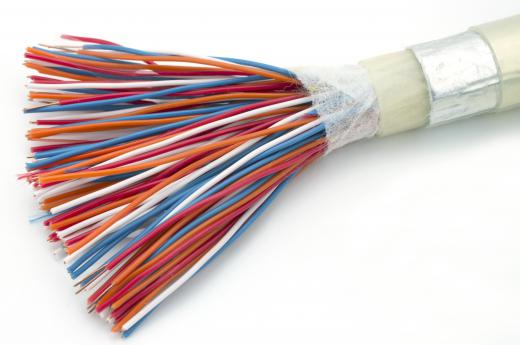A trirated cable is unique in that it meets three different international standards and is made to create electrical panels. The trirated cable itself is built from a copper conductor and polyvinyl chloride (PVC) insulation. While commonly referred to as a single type of cable, there are many trirated cables with different sizes and resistances. A non-toxic variant of this cable is necessary if the cable is used in a public place because, if a standard cable catches on fire, the smoke is extremely toxic.
To be a true trirated cable, it must pass three international standards. British Standard 6231 (BS6231) is a standard given to cables that include a single core, use PVC insulation and have a voltage rating between 600 and 1,000 volts (V). With the Canadian Standards Association (CSA), trirated cables are given the number C22.2, 49; this standard rates flexible and elevator cable, and the cable must be rated at 600V maximum. The third standard is from the Underwriters Laboratory™ (UL™), which approves trirated cables under the UL62 standard, specified for flexible cables.

Many manufacturers say they are selling trirated cables when they really are not, either because the manufacturer does not understand what a true trirated cable is or wants to bolster cable sales. Manufacturers may incorrectly market the cable, because it meets one of the safety standards. True trirated cables must meet all three standards simultaneously, and the logo of the standards will usually appear on the packaging.
Trirated cable is built from two parts. Inside the cable, there is the conductor wire, responsible for conducting electricity. This core is made from plain copper that has a Class 5 flexibility, meaning it is very flexible. The outside insulation is heat-resistant PVC, which protects operators from the heat of the wire when it is operating and protects the internal wire from outside forces. This insulator comes in many different colors, including blue, orange, red and green.
While a trirated cable must pass all three standards, there are many different trirated cables. The cable’s construction will have differently sized cores and insulation, making the cable useful for different operations. The amount of energy that each cable can conduct also will be different, depending on the size of the conductor.
If a trirated cable is used to create an electrical panel in a public place, then it needs to be a special, non-toxic cable. These wires must release low amounts of smoke and no halogen. This is because, if they catch on fire, regular trirated cables release toxic levels of halogen, quickly resulting in death.
